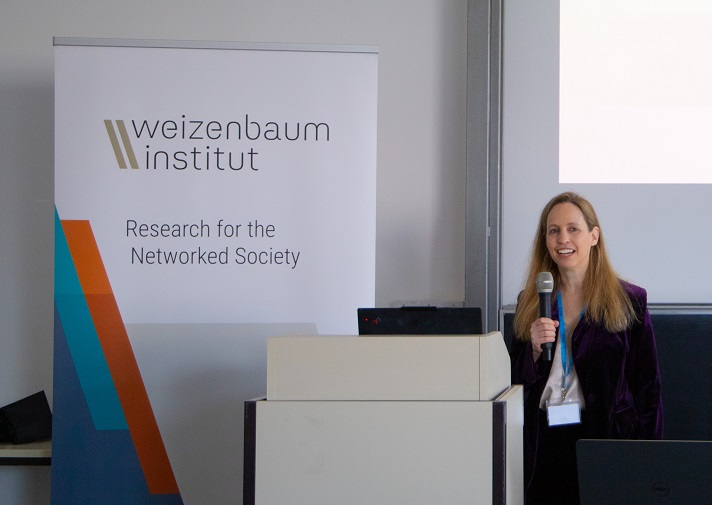
How Media shapes the Future
10.06.2025How does the media we consume shape the way we see the future? This is one of the key questions driving the research of Prof. Keren Tenenboim-Weinblatt, distinguished fellow at the Weizenbaum Institute. In this interview, she shares insights from her work on how different types of media influence whether people feel hopeful or pessimistic about society and politics.
How do you approach the question of media’s influence on optimism and pessimism within your research field of political communication and journalism?
I approach this question from both a production and a reception perspective. On the production side, I study how journalists construct projections about the future—particularly during elections and times of crisis—and how they navigate the ethical and professional tensions involved. On the reception side, I examine how audiences respond to mediated representations of the future, primarily through focus groups and panel surveys.
This dual approach has been central to the PROFECI project (funded by the ERC), which investigates the social dynamics of public projections, as well as to my new collaboration with Neta Kligler-Vilenchik, which focuses on social optimism—broadly defined as positive expectations regarding collective futures.
In which way do different types of media affect social and political optimism?
Different media outlets offer different narratives about the future—especially in polarized environments—and we see clear differences between people with different media diets. It’s common to assume that news exposure increases pessimism and suppresses optimism, due to the negativity bias both in news content and in what audiences tend to focus on. But the picture is more complex. For instance, we observe notable differences between people who consume mainstream news and those who follow alternative media—they often hold almost mirror-opposite views of the future and how optimistic they feel about it.
Have you observed differences in the effects of media based on their political orientation—for example, left-leaning versus right-leaning outlets?
Media effects on optimism are indeed deeply intertwined with political orientation. Right-leaning and left-leaning outlets often construct competing visions of the future, and people tend to gravitate toward sources that align with their ideological views and emotional expectations—a dynamic shaped by wishful thinking and optimism bias.
However, the direction of media influence depends on the political context. For instance, when a right-wing government is in power, right-leaning media are more likely to promote an optimistic outlook, whereas left-leaning media may foster a more critical or pessimistic view, and vice versa.
You focus on cases such as the Israel-Hamas war and the French election in 2022. What national differences have you found? And do social factors like gender, age, ethnicity, or socio-economic status also influence how media affects people’s outlooks?
We see important national and social variations. Beyond the cultural baseline differences in optimism between Israel and France—even during one of the most devastating periods in Israeli history, Israelis were overall more optimistic about their country’s future than French citizens—we also found striking contrasts in the effects of right-wing alternative media.
In Israel, watching the right-wing Channel 14 was associated with increased optimism, whereas in France, exposure to the equivalent outlet, CNews, was linked to decreased optimism. This difference—connected to what we’ve just discussed—relates to the political context and whether a right-wing government is in power.
We also find that social optimism varies by identity-based factors such as religiosity and political affiliation. Importantly, in both countries, we controlled for these variables and still found a significant association between media consumption and optimism.
In times of crisis, is pessimism within the media reporting helpful to raise awareness or would more optimism be beneficial to mobilize for a solution?
This is a difficult and normative question—and one I’ve come to think about more during my time at the Weizenbaum Institute. Pessimism can alert us to real dangers, but excessive negativity can lead to despair and demobilization. Optimism, on the other hand, can inspire action and serve as a self-fulfilling prophecy, but it risks becoming detached from reality.
The key may lie in what I call “clear-eyed optimism”—an outlook that acknowledges challenges while creating space for constructive engagement. Media can play a critical role here: not by sugar-coating reality, but by highlighting agency, possibilities, and diverse future pathways. In deeply divided societies, such efforts are not just editorial choices—they’re moral ones.
What roles do journalists, activists, and politicians play in shaping public expectations for the future through media?
Each of these actors plays a role in constructing the collective imagination of what lies ahead. Journalists are central—not only in mediating the future-oriented statements and actions of others, but also in formulating their own projections. Yet, as we found in our interviews with political journalists, many are deeply ambivalent about forecasting, viewing it as risky and at odds with core journalistic norms. I argue that this reluctance to fully engage with the uncertainty of political futures can limit journalists’ ability to meaningfully contribute to public deliberation and decision-making as societies navigate what’s to come.
Politicians and activists, meanwhile, often produce more emotionally charged and strategic projections—especially on social media—aimed at mobilizing publics. These projections are then amplified or contested by journalists, generating a complex media ecology in which collective futures are being continuously constructed and negotiated.
Understanding how these different actors shape public outlooks is crucial for grasping the dynamics of democratic engagement in times of uncertainty.
Thank you!
The Interview was conducted by Katharina Stefes